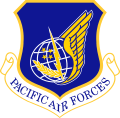36th Fighter Squadron | |
|---|---|
 | |
| Active | 1917–1919; 1930–present |
| Country | |
| Branch | |
| Type | Fighter |
| Part of | Pacific Air Forces 7th Air Force 51st Fighter Wing 51st Operations Group |
| Garrison/HQ | Osan Air Base, Korea |
| Nickname(s) | The Flying Fiends |
| Motto(s) | Check Six! Harrumph! |
| Mascot(s) | Tojo |
| Anniversaries | The Fiend Centennial (28 Sep – 1 October 2017 Osan AB, ROK) |
| Engagements | World War I World War II Korean War Vietnam War |
| Decorations | Distinguished Unit Citation Presidential Unit Citation Air Force Outstanding Unit Award Philippine Presidential Unit Citation Republic of Korea Presidential Unit Citation Republic of Vietnam Gallantry Cross with Palm |
| Commanders | |
| Current commander | Lt Col Nicholas Haussler |
| Notable commanders | Quentin Roosevelt Ennis Whitehead Major General Scott D. West |
| Insignia | |
| 36th Fighter Squadron emblem [note 1] [1] |  |
| 36th Tactical Fighter Squadron emblem [note 2] [2] |  |
| 36 Tactical Fighter Squadron emblem [note 3] [2] |  |
| 36th Pursuit Squadron emblem [note 4] [3] |  |
The 36th Fighter Squadron is part of the US Air Force's 51st Operations Group at Osan Air Base, South Korea. It operates the General Dynamics F-16 Fighting Falcon aircraft conducting air superiority missions. The squadron was first activated in 1917 as the 36th Aero Squadron and served in France during World War I, although the war ended before the unit saw combat. It has been continuously active since 1930 as a fighter squadron.
Contents
- History
- World War I
- Interwar period
- World War II
- Korean War
- Vietnam War
- Post Cold War
- Lineage
- Assignments
- Stations
- Aircraft
- See also
- References
- Notes
- Citations
- Bibliography
- External links
The squadron mission is to conduct suppression of enemy air defenses (SEAD), air interdiction, close air support, and counter-air missions both day and night. It participates in the defense of South Korea [4] and operates further afield.






